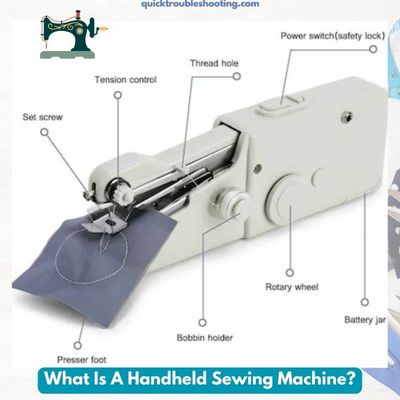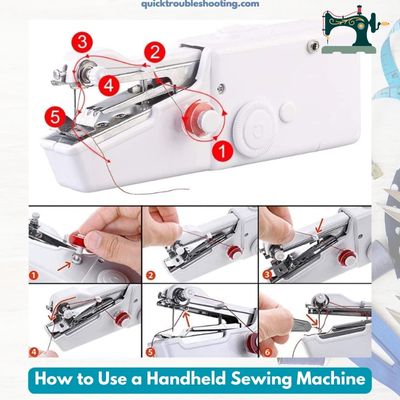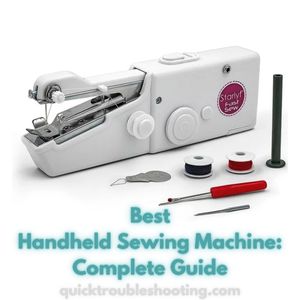5 Best Handheld Sewing Machine: Сomplete Guide
Ever wondered, “What is the Handheld Sewing Machine?” Picture a sewing machine that conveniently fits in the palm of your hand, enabling you to sew anytime, anywhere. The marvels of modern technology have brought forth portable sewing machines, now easily accessible at your local haberdashery or online.
These compact wonders are no longer just tools; they’re an addition to your handbag essentials! Explore our snippet-format recommendations to find the perfect handheld sewing machine for your stitching needs.
Discover the ultimate guide to the Best Handheld Sewing Machine!
Best Handheld Sewing Machine Tutorial
What Is A Handheld Sewing Machine?
A Handheld Sewing Machine is a nifty and compact device specifically crafted for sewing and mending tasks. Its design prioritizes portability, making it markedly smaller and lighter than its traditional sewing machine counterparts.

This distinctive feature allows for unparalleled convenience, enabling users to take it along on holidays or easily store it in a drawer, catering to homes with limited space that may not accommodate a full-sized machine.
Resembling an oversized office stapler in appearance, the handheld sewing machine is not a replacement for a comprehensive sewing machine but serves as an invaluable tool for mending or handling small household projects.
Its user-friendly nature makes it an ideal choice for older kids keen on exploring sewing with a cordless and compact handheld device.
The compactness of these machines is truly noteworthy, with some models so diminutive that they can effortlessly fit into your luggage or handbag. Picture having a sewing tool akin to a large staple gun at your disposal, discreetly nestled in your bag, ready to tackle any straightforward sewing job that comes your way.
The handheld sewing machine emerges as a versatile and practical solution, making sewing on-the-go or handling minor repairs around the house a breeze.
Handheld Sewing Machine Key Attributes Table
| Key | Description |
|---|---|
| Definition | A Handheld Sewing Machine is a compact device designed for sewing and mending tasks, prioritizing portability over traditional counterparts. |
| Portability | Markedly smaller and lighter, it offers unparalleled convenience, suitable for travel or storage in limited spaces. |
| Appearance | Resembling an oversized office stapler, it is not a replacement for comprehensive machines but serves well for mending and small projects. |
| User-Friendly | Ideal for older kids exploring sewing, providing a cordless and compact option. |
| Compactness | Some models are so diminutive they fit into luggage or handbags, offering discreet accessibility. |
| Versatility | Comparable to a large staple gun, it serves as a practical solution for on-the-go sewing or handling minor repairs around the house. |
| Practicality | Emerges as a versatile tool, making sewing tasks easier and more convenient in various situations. |
| Accessibility | Easily available at local haberdasheries or online, adding convenience to the procurement process. |
| Handy Solution | An addition to handbag essentials, it’s ready to tackle straightforward sewing jobs wherever you go. |
| Limitations | Not a comprehensive replacement for larger machines; best suited for smaller projects and quick fixes. |
| Ideal Usage | Perfect for quick fixes, travel, and compact living spaces where a full-sized machine may be impractical. |
| Technology Advancements | Marvels of modern technology have made these devices efficient and accessible to a wider audience. |
| Youth Exploration | Offers a user-friendly option for older kids interested in learning and exploring sewing skills. |
| Noteworthy Compactness | Highlighting the remarkable size that allows it to be discreetly carried for various sewing needs. |
| Cordless Convenience | The handheld nature of the device eliminates the need for cords, enhancing convenience during use. |
| Household Applications | Valuable for handling minor repairs and sewing tasks around the house, making it a practical addition to household tools. |
| Ease of Storage | Its compact design allows easy storage in drawers, catering to homes with limited space. |
Quick Answer: What Is The Best Handheld Sewing Machine?
The top recommendation for the best handheld sewing machine is the Singer Stitch Sew portable sewing machine. Combining excellent brand reputation with a reasonable price point, it also includes essential accessories for your sewing needs. To kickstart your sewing journey with this machine, make sure to have 4 AA batteries on hand.
Advantages Of A Handheld Sewing Machine:
- Portable Perfection: A standout advantage of handheld sewing machines lies in their portability. Boasting a lightweight and compact design, these machines are the ideal companions for on-the-go stitching needs. Take them on holiday for quick repairs without the hassle of lugging around a bulky sewing apparatus.
- Convenience at Hand: The handheld sewing machine’s compact size makes it a convenient addition to your handbag or holiday case. Perfect for impromptu fixes and small DIY projects, it ensures you’re always prepared for stitching emergencies.
- Ease of Operation: These machines are exceptionally easy to handle, catering to beginners and seasoned sewers alike. Even if you’re new to sewing, the learning curve is minimal, allowing you to operate the machine with confidence.
- Mending Marvel: An invaluable tool for repairs, handheld sewing machines excel at handling hems and small alterations around the house. They provide a quick and efficient solution for tackling minor sewing tasks without the need for a full-sized machine.
- Economical Excellence: Budget-friendly is an understatement. With prices ranging from $15 to $20 USD, these machines offer a cost-effective alternative for those seeking a practical sewing solution without breaking the bank.
- Cordless Convenience: Bid farewell to irritating cords as handheld sewing machines operate cordlessly. This feature is particularly advantageous when working on small areas of fabric, providing unrestricted movement and ease of use.
- Attachment Advantages: Many models come equipped with useful attachments, although it’s worth noting that batteries and the DC/AC adaptor may not always be included. Ensure you have the necessary power sources to make the most of your portable sewing experience.
- Diverse Choices: The market offers a plethora of handheld sewing machine models, providing you with the flexibility to choose one that suits your preferences and needs. Stick with reputable brands to ensure quality and performance.
Disadvantages Of A Handheld Sewing Machine:
- Limited Fabric Range: One significant drawback is the limitation on the types of fabrics these machines can handle. Primarily designed for lighter fabrics like cotton, light linen, wool, silk, nylon, and polyester, they may fall short when it comes to sewing heavier fabrics such as denim. If your sewing ambitions include jeans or other robust materials, investing in a cheap regular sewing machine might be a more suitable long-term solution.
- Not Designed for Large Projects: Handheld sewing machines are not geared for large-scale sewing projects or prolonged usage. Their design caters to quick fixes and small tasks, making them less flexible for extended or intensive sewing sessions.
- Sewing on the Edge: Another limitation lies in the sewing pattern, as these machines can only sew along an edge. While suitable for many projects, this constraint may pose challenges for those requiring a broader range of stitching options.
Choosing the Best Handheld Sewing Machine: A Comprehensive Guide
Selecting the optimal handheld sewing machine amidst the myriad options can be daunting, but a few key considerations can steer you toward the right choice. Here’s a detailed guide to help you make an informed decision:
1. Reliability in Brand Names: When navigating the sea of handheld sewing machines, consider the reliability of brand names. Renowned brands often bring a legacy of quality and performance. Look for brands like Singer, known for their sewing machine expertise.
2. Essential Features to Look For:
- Detailed Instructions: Seek machines that come with comprehensive and easy-to-follow instructions, catering to both beginners and experienced users.
- Accessories and Spares: Check for included accessories and spare parts, such as needles, bobbins, and threaded spindles, enhancing the machine’s versatility.
- On/Off Button Position: Evaluate the placement of the on/off button for convenient and efficient operation.
- Ease of Handling: Opt for a machine that is user-friendly, ensuring ease of handling even for those new to sewing.
- Portability: Assess the machine’s portability, a crucial factor for those on the go. Compact size and lightweight design contribute to the convenience of transport.
3. Price Comparison: Reasonable Pricing: While most handheld sewing machines fall within a reasonable price range (typically $15-$20 USD), it’s advisable to compare prices across different models to ensure you’re getting the best value for your money.
5 Top Handheld Sewing Machine Recommendations:
1. StingSew Handheld Sewing Machine:
- Overview: Amazon’s choice for handheld sewing machines, the Stingsew, closely resembling the Singer, boasts portability and ease of use.
- Features: Operates with 4 AA batteries (not included), optional power cord, and claims to sew leather and denim (ideal for light to medium-weight fabrics).
- Recommendation: Well-suited for mending and simple projects, provided realistic expectations are maintained regarding fabric weight.
2. Singer Handheld Sewing Machine:
- Overview: Backed by the Singer brand, this portable machine is designed for small mending jobs and minor sewing projects.
- Features: Comes with needles, bobbins, threaded spindles, needle threader, and recommended for various fabric types.
- Recommendation: Ideal for holiday use, repairs, and small tasks around the house, emphasizing lighter fabrics for optimal results.
3. Sunbeam Handheld Sewing Machine:
- Overview: A brand comparable to Singer, the Sunbeam handheld sewing machine offers similar attributes and portability.
- Features: Available in red-and-white or black-and-white color options, with recommendations mirroring the advice for the aforementioned brands.
- Recommendation: Best suited for sewing light fabrics and mending, maintaining realistic expectations.
4. Magicfly Mini Sewing Machine:
- Overview: Slightly larger than typical handheld machines, the Magicfly offers AC/DC and battery power options.
- Features: Includes a foot pedal for operation, adjustable sewing speed, and comes with a mini sewing kit.
- Recommendation: While less portable than others, it provides additional features and is suitable for users seeking a slightly larger handheld option.
5. Mini Hand Sewing Machine:
- Overview: Metsoo’s portable handheld sewing machine is designed for on-the-go use with a compact and space-saving design.
- Features: Manual control for user-friendly precision, versatility in handling various materials including fabric, jeans, and leather.
- Recommendation: Ideal for both home and travel use, particularly convenient for beginners due to its manual control.
When choosing the best handheld sewing machine, consider your specific needs, the brand reputation, and the features offered by each model. Whether you prioritize portability, brand trustworthiness, or additional functionalities, this comprehensive guide ensures you make a well-informed decision tailored to your sewing requirements.
How to Use a Handheld Sewing Machine: A Comprehensive Guide
Congratulations on acquiring your new handheld sewing machine! To ensure a smooth start, follow this detailed guide, which serves as a quick start reference for most brands. Always refer to the instruction manual provided with your specific model for additional guidance.

Step 1: Turn On the Power
Your handheld sewing machine operates on batteries, making it fully portable. While it can be electrically powered, you’ll need a DC6V power adaptor, usually not included. For travel convenience, batteries are recommended, eliminating the need for power converters in different countries.
Step 2: Operating the Machine
Once threaded and ready to sew, the handheld machine proves to be incredibly light and easy to handle. Follow these steps:
- Locate the ON button and power up the machine.
- The handheld sewing machine is designed to be user-friendly, so you can initiate the sewing process with ease.
Step 3: Choosing Fabrics and Best Practices
While these machines claim to sew all types of fabrics, optimal results are achieved with lightweight fabrics. If your sewing project involves heavier materials like denim, it’s advisable to use a regular sewing machine for better performance.
Step 4: Threading the Handheld Machine
Refer to the specific instructions provided with your machine for threading guidance. Generally, these compact devices use a single straight stitch and come equipped with a bobbin thread attachment.
- Thread the handheld machine following the provided instructions.
- Ensure the needle is correctly inserted at the front of the machine.
Step 5: Sewing Process
The fabric to be sewn is slotted into the front of the machine. Follow these steps for a successful sewing experience:
- Position the fabric in the designated slot at the front of the machine.
- Activate the sewing process by pressing the ON button.
- The stitching runs along the side of the fabric, creating a single straight stitch.
Additional Tips:
- Always read and follow the instruction manual accompanying your handheld sewing machine for model-specific guidance.
- For optimal results, stick to lightweight fabrics when using a handheld sewing machine.
- If you encounter challenges sewing heavier fabrics like denim, consider using a regular sewing machine for more robust performance.
FАQ
1. Are Hand Held Sewing Machines Any Good?
Answer: Handheld sewing machines can be useful for certain tasks, such as quick repairs and simple projects. However, their effectiveness depends on the user’s expectations and the specific model. While they excel at portability and convenience, they may have limitations when it comes to handling heavier fabrics or more complex sewing projects. It’s essential to have realistic expectations and understand that they are designed for light to medium-weight fabrics and small-scale tasks.
2. What Stitches Can Handheld Sewing Machines Do?
Answer: Handheld sewing machines typically perform a single straight stitch. This stitch is suitable for basic sewing needs, such as mending, hemming, and simple projects. While they may not offer the variety of stitches found in traditional sewing machines, their simplicity makes them easy to use, especially for beginners. Users should be aware that the primary function of handheld sewing machines is to provide a quick and portable solution for straightforward sewing tasks.
3. Can Handheld Sewing Machines Handle Heavy Fabrics?
Answer: Handheld sewing machines are generally designed for lightweight to medium-weight fabrics. While some models may advertise the ability to sew heavier materials like denim, users often find that the results may not be as satisfactory as with a regular sewing machine. It’s recommended to reserve handheld machines for lighter fabrics and minor repairs. For projects involving heavy fabrics, a traditional sewing machine with more power and capabilities would be a better choice.
4. Do Handheld Sewing Machines Offer Multiple Stitching Options?
Answer: Handheld sewing machines typically provide a single straight stitch and may not offer a variety of stitching options. These machines are designed for simplicity and ease of use, making them suitable for quick fixes and basic sewing tasks. If a broader range of stitches is a requirement, users may need to consider traditional sewing machines that come equipped with more advanced features.
5. Are Handheld Sewing Machines Suitable for Large Projects?
Answer: Handheld sewing machines are not well-suited for large-scale projects or extended use. Their compact size and limited features make them more suitable for on-the-go repairs and small tasks around the house. Attempting to use a handheld machine for extensive sewing projects may result in frustration, as they are designed to handle minor tasks efficiently. For larger projects, it’s advisable to opt for a regular sewing machine with the necessary capabilities and features.
Conclusion: Best Handheld Sewing Machine
In conclusion, choosing the best handheld sewing machine involves considering various factors such as brand reputation, features, and your specific sewing needs. The Singer Stitch Sew, Singsew, Sunbeam, Magicfly, and Metsoo are among the top contenders, each offering portability, user-friendly operation, and practicality for on-the-go stitching.
It’s crucial to prioritize realistic expectations, particularly regarding fabric types, and to refer to the individual machine’s instructions for optimal performance. Whether you prioritize brand trustworthiness, additional features, or compact design, the best handheld sewing machine for you will align with your unique preferences and requirements. Happy sewing!
